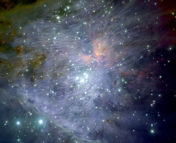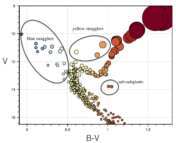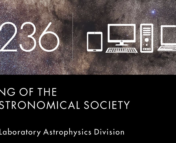Title: When the tale comes true: multiple populations and wide binaries in the Orion Nebula Cluster
Authors: Tereza Jerabkova, Giacomo Beccari, et al.
First Author’s Institution: European Southern Observatory, Karl-Schwarzschild-Straße 2, 85748 Garching bei München
Status: Accepted for publication in Astronomy and Astrophysics (A&A), open access on arXiv
The Orion Nebula has been a top target for astronomers and their fancy cameras for over a century. In fact, a photo of the Orion Nebula by the amateur astronomer and astrophotographer Andrew Ainslie Common from 1883 was the first demonstration that a long exposure photograph could reveal stars that were too dim to be seen by eye. Thanks to modern-day telescopes, we now know the Orion Nebula to be a large cloud of gas and dust that is actively forming new stars. The newly formed stars in and around the nebula are collectively referred to as the Orion Nebula Cluster (ONC).

Figure 1. Left: Andrew Ainslie Common’s photo of the Orion Nebula from 1883; Middle: the Orion Nebula as seen by the VLT Survey Telescope (image credit: ESO); Right: The Orion Constellation. The Orion Nebula is the bright smudge-like object in the middle of Orion’s sword (the vertical line of stars under Orion’s Belt).
Not all stars are born together
One of the assumptions made about star clusters is that all of the stars are born at more or less the same time, within approximately one million years. Not so for the ONC! Two years ago, observations made using the OmegaCAM instrument in the VLA Survey Telescope were able to pick out not one, not two, but three distinct populations of stars living in the ONC, suggesting that star formation may not have happened all at once but rather in three separate bursts.
To arrive at this conclusion, the authors created a Color-Magnitude Diagram (CMD), on which newly formed stars of the same age appear to form a line called the Pre-Main Sequence. By making a CMD of the stars seen in the ONC, the authors were able to pick out three distinct sequences indicating that these three groups of stars all formed at different times.
Since this discovery two years ago, theorists have revisited their models for how star formation progresses in regions like the Orion Nebula, and proposed mechanisms that would allow for multiple bursts of star formation. The emerging picture involves a collapsing cloud of gas and dust that forms a population of stars. Once enough big and bright stars have formed, they begin heating up the gas around them and blowing it away, temporarily stalling the star formation process. At the same time, those stars begin to move away from the star-forming region, diminishing their influence and allowing the gas to re-collapse and form more stars. This process is thought to repeat multiple times leading to several bursts of star formation.
But wait, there’s another explanation…
In their 2017 paper, the authors acknowledged a second possible explanation for the multiple sequences that casts doubt on this whole theory. The same triple sequence in the CMD can also be explained if all the stars formed at the same time, as long as a subset of them reside in unresolved binary systems. The stars in the unresolved binaries are so close to each other that to our telescopes each binary appears as a single star. If enough stars are in equal-mass unresolved binaries, they can form what appears to be a distinct secondary sequence above the primary sequence of individual stars on the CMD, because a binary system appears brighter than an individual star would be at the same color. Not only that, this secondary sequence would fall almost exactly in the same location as the observed secondary sequence in the ONC, as shown in the right-hand panel of Figure 2. A smaller subset of unresolved triple systems could account for the third population.
A major shortcoming of this alternate explanation is that it requires the vast majority of binary and triple systems to be composed of stars with a specific mass ratio. But even in light of this caveat it still offers a plausible alternative to the multi-population scenario.

Figure 2. Left: CMD from today’s paper of the ONC stars. The gray line goes through the primary population, while the second and third populations are located to the right of the primary population. Middle: a magnified and rotated version of the same CMD projected such that the three populations appear as vertical columns. Right: a Histogram of the color differences between the stars in the ONC (made from the middle plot) showing the three distinct populations. The three vertical grey lines indicate the location of single stars, unresolved binaries, and unresolved triple systems (from left to right) under the competing hypothesis that all of the stars formed at the same time. The red histogram at the bottom shows the estimated number of binaries that remain after the filtering process carried out in today’s paper — clearly insufficient to explain the second and third peaks in the data (Figure 3 from today’s paper).
Unresolved binaries begone!
In today’s paper, the same group performed follow-up observations of the ONC to resolve the degeneracy. This time, they were able to supplement their photometric observations from OmegaCAM with the precise astrometric data from the Gaia Space Telescope, which turned out to be particularly helpful for removing some of the imposter stars. After confirming the same triple sequence from their previous paper, they conducted a series of tests to filter out the potential unresolved binaries. A comparison with an existing catalog of known unresolved binary systems in the ONC confirmed that their filtering process successfully removed approximately 80% of the unresolved binaries.
As shown in the solid red histogram in the right-hand panel of Figure 2, the projected number of remaining unresolved binaries is now insufficient to explain the triple sequence. The binary system hypothesis was somewhat unlikely to begin with, but with this new data, the authors seem to have put it to rest entirely. It appears, therefore, that the three observed sequences in the ONC are indeed three distinct populations of stars that were born at different times.




